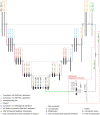Objective quantification of nerves in immunohistochemistry specimens of thyroid cancer utilising deep learning
- PMID: 35226665
- PMCID: PMC8912900
- DOI: 10.1371/journal.pcbi.1009912
Objective quantification of nerves in immunohistochemistry specimens of thyroid cancer utilising deep learning
Abstract
Accurate quantification of nerves in cancer specimens is important to understand cancer behaviour. Typically, nerves are manually detected and counted in digitised images of thin tissue sections from excised tumours using immunohistochemistry. However the images are of a large size with nerves having substantial variation in morphology that renders accurate and objective quantification difficult using existing manual and automated counting techniques. Manual counting is precise, but time-consuming, susceptible to inconsistency and has a high rate of false negatives. Existing automated techniques using digitised tissue sections and colour filters are sensitive, however, have a high rate of false positives. In this paper we develop a new automated nerve detection approach, based on a deep learning model with an augmented classification structure. This approach involves pre-processing to extract the image patches for the deep learning model, followed by pixel-level nerve detection utilising the proposed deep learning model. Outcomes assessed were a) sensitivity of the model in detecting manually identified nerves (expert annotations), and b) the precision of additional model-detected nerves. The proposed deep learning model based approach results in a sensitivity of 89% and a precision of 75%. The code and pre-trained model are publicly available at https://github.com/IA92/Automated_Nerves_Quantification.
Conflict of interest statement
The authors have declared that no competing interests exist.
Figures














References
-
- Pundavela J, Roselli S, Faulkner S, Attia J, Scott RJ, Thorne RF, et al.. Nerve fibers infiltrate the tumor microenvironment and are associated with nerve growth factor production and lymph node invasion in breast cancer. Mol Oncol. 2015;9(8):1626–35. doi: 10.1016/j.molonc.2015.05.001 - DOI - PMC - PubMed
Publication types
MeSH terms
LinkOut - more resources
Full Text Sources
Medical

